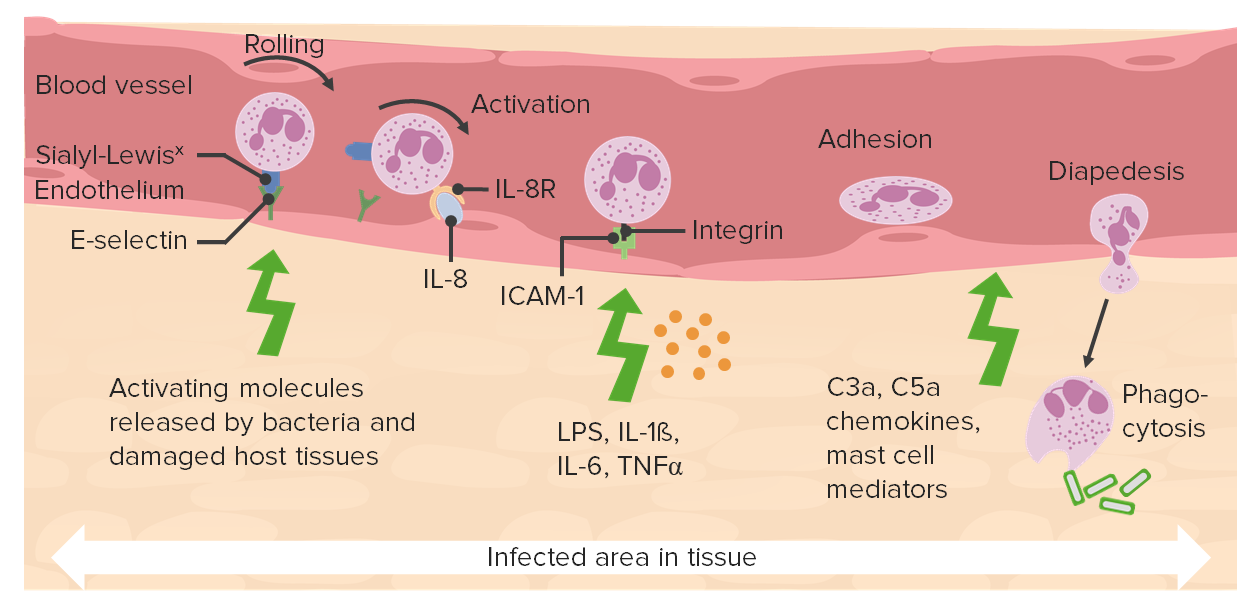Playlist
Show Playlist
Hide Playlist
Inflammatory Chemokines
-
Slides Acute and Chronic Inflammation Cellular response.pdf
-
Reference List Pathology.pdf
-
Download Lecture Overview
00:01 I've used chemokines, but haven't explained what they are. 00:03 So here's a quick definition. 00:05 Chemokines, or any of our variety of proteins that can recruit and activate inflammatory, and even non-inflammatory cells. 00:13 They are expressed by basically every cell type that you can think of. 00:16 And there are a whole mess of chemokines. 00:19 So we're going to give a little bit more explanation about those in a minute because those are important molecules in many of the inflammatory processes. 00:28 Right then, so we have talked about chemokines. 00:31 They're actually over 50 different kinds of chemokines. 00:34 They live in four different families. 00:37 They're going to be just two that we really need to pay attention to, but there are four families. 00:41 Shown here is the typical structure of a chemokine. 00:45 It kind of looks like a paperclip. 00:48 In one end is the carboxyl-terminus, that's the COOH. 00:52 On the other end is the NH2, that's the amino-terminus. 00:55 And they typically fold like a paperclip held together by two disulfide bonds. 01:00 The disulfide bonds are between cysteines, marked here as C's. 01:04 So those are giving you the disulfide bonds linking and holding together the paperclip. 01:10 For CXC chemokine, there is a preserved motif of that central cysteine separated by some other amino acid, not otherwise specified, it's just X, and then another cysteine. 01:23 So they're called CXC chemokines. 01:26 So they are important because as shown in the red box, they typically recruit neutrophils. 01:32 There are exceptions, but they typically recruit neutrophils, and this will show up on boards, because you'll, they'll ask, with a CXC chemokine, what does it do? Recruits neutrophils. 01:42 There is a CC chemokine. 01:44 Same general structure, same paperclip, same carboxyl-terminus, same amino group. 01:49 But instead of having an amino acid between the two cysteines there's nothing, it's just CC. So they're together. 01:57 Same disulfide bonds holding the paperclip together, but CC chemokines, that's slightly different structure will now typically recruit only mononuclear cells. 02:07 So we have these two very important families of chemokines, and depending on when they're expressed, and how they're expressed, will either recruit neutrophils or recruit mononuclear inflammatory cells. 02:19 There are others in the families, so there is just a single cysteine and nothing else. 02:24 And then we have cysteine separated by three amino acids. 02:29 But we're gonna focus on the CXC and the CC chemokines. 02:33 What are they binding to? Those chemokines bind 2 receptors. 02:36 And they're pretty impressive in terms of the complexity, but they span the membrane seven times, and they are linked to G-proteins. 02:44 So there can be intracellular signaling. 02:46 So the chemokine will come along, sit down on top of the chemokine receptor, and signal intracellularly. 02:54 The signals, once that happens, we'll trigger for example, changing the integrants from low affinity to high affinity. 03:03 But chemokines can also drive just pure cell migration. 03:07 They may be like a whiff of perfume on the air that a neutrophil follows on its way to getting to a particular site. 03:16 So they will drive particular migration in a direction. 03:20 They may also induce cellular proliferation, and they may induce other cellular activation. 03:26 So chemokines and chemokine receptors, do a lot of things. 03:31 We'll come back to review slide in just a minute that will put it in context. 03:34 So hang in there.
About the Lecture
The lecture Inflammatory Chemokines by Richard Mitchell, MD, PhD is from the course Acute and Chronic Inflammation.
Included Quiz Questions
Which of the chemokine families typically recruits neutrophils?
- -CXC- chemokine family
- -CC- chemokine family
- -C- chemokine family
- -CX2C- chemokine family
- -CX3C- chemokine family
The chemokine-induced intracellular signaling is involved in...?
- ...cell migration.
- ...apoptosis.
- ...cell inhibition.
- ...angiogenesis.
- ...tissue remodeling.
Customer reviews
5,0 of 5 stars
| 5 Stars |
|
5 |
| 4 Stars |
|
0 |
| 3 Stars |
|
0 |
| 2 Stars |
|
0 |
| 1 Star |
|
0 |




